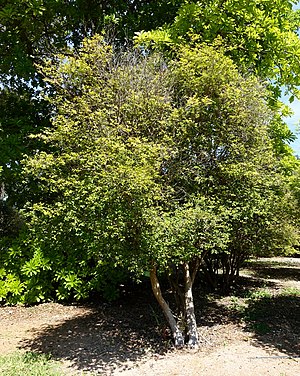Plinia cauliflora
| Plinia cauliflora | ||||||||||||
|---|---|---|---|---|---|---|---|---|---|---|---|---|

Plinia cauliflora |
||||||||||||
| Systematics | ||||||||||||
|
||||||||||||
| Scientific name | ||||||||||||
| Plinia cauliflora | ||||||||||||
| ( Mart. ) Kausel |
Plinia cauliflora or the tree trunk cherry , also Jaboticaba , is a small tree in the myrtle family from southeastern Brazil to Argentina and Paraguay as well as Bolivia .
description
Plinia cauliflora grows as a small, often multi-stemmed and evergreen , slow-growing shrub or tree up to 6–10 meters high, rarely a little higher. The smooth bark is flaky and orange-brown to grayish.
The simple, short-stalked, leathery leaves are opposite and up to 4–8 centimeters long. The short petioles are hairy downy. The bare leaves are ovate to elliptical, with entire margins and pointy to pointed.
There are small, ordinary educated or astblütige, short and wenigblütige, tufted inflorescences. They are underlaid by several bracts . The small flowers are four-fold with a double flower envelope . There are small front pages. They are almost sessile to short stalked, whitish and have many long stamens (45-60) that sit on a cup-shaped flower base . The petals fall off very early. The ovary is subordinate.
Small, round, black-purple and smooth berries ( false fruit ) with a firm, tough, blackish and shiny skin are formed , about 1.5–3.5 centimeters in size . They contain 1–4 seeds and have light flower cup and calyx remains at the tip. The slightly translucent pulp is whitish, juicy and gelatinous.
Taxonomy
The first description of Basionyms Myrtus cauliflora was made in 1823 by Carl Friedrich Philipp von Martius in travel Bras. 1: 285. The new combination to Plinia cauliflora took place in 1956 by Eberhard Max Leopold Kausel in Arkiv för Botany (a. S.) 3: 508. Other synonyms are e.g. B. Myrciaria cauliflora (Mart.) O.Berg , Myrciaria jaboticaba (Vell.) O.Berg , Myrtus jaboticaba Vell. , Plinia jaboticaba (Vell.) Kausel u. a., whereby the taxonomy is controversial.
use
The fruits can be eaten raw, processed into jellies, syrups, liqueurs and jams, or fermented into wine.
literature
- JE Hernández Bermejo, J. León: Neglected Crops: 1492 from a Different Perspective. FAO Plant Production and Protection Series No. 26, FAO, 1994, ISBN 92-5-103217-3 , p. 229 f.
- Odilo Duarte, Robert Paull: Exotic Fruits and Nuts of the New World. CABI, 2015, ISBN 978-1-78064-505-6 , pp. 51-60.
Web links
- Plinia cauliflora at Useful Tropical Plants.
- The tree trunk cherry : Plinia cauliflora at flora-obscura.de, accessed on October 1, 2019.
- Jaboticaba at Growables, accessed October 1, 2019.
- Jaboticabas at Purdue.
Individual evidence
- ↑ Plinia cauliflora at KEW Science.
- ↑ Fred R. Barrie. Synopsis of Plinia (Myrtaceae) in Mesoamerica. In: Novon. Vol. 14, No. 4, 2004, pp. 380-400, JSTOR 3393536 .

